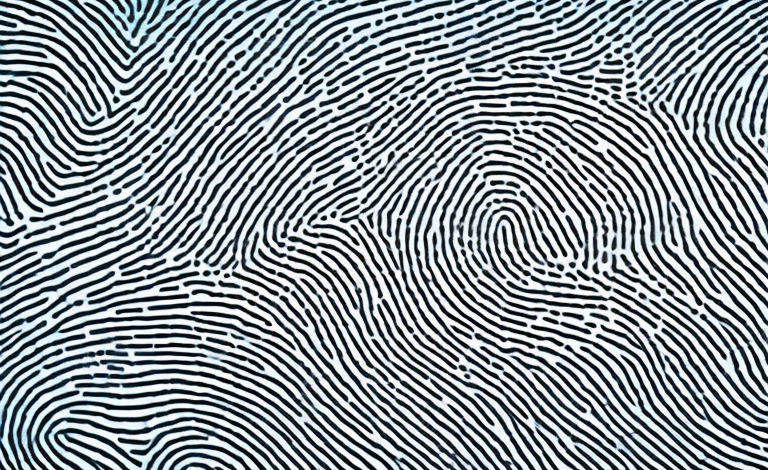Fingerprints have been used as a unique identifier for over a century. The science behind this method of identification has progressed significantly since its early days, but a concern remains: do fingerprints fade over time? The answer is not as simple as a yes or no. Multiple factors can impact the longevity of fingerprints, including age, genetics, environmental conditions, and more. In this article, we will delve into the science behind the formation and maintenance of fingerprints, explore the various factors that can affect their visibility, and examine the implications of fingerprint analysis in forensic investigations.
The Science behind Fingerprint Identification
The unique patterns of ridges and furrows on our fingertips are formed in the womb and remain unchanged throughout our lives, making them an excellent tool for identification. The three main types of patterns are loops, whorls, and arches, each with their own subtypes. The uniqueness of fingerprints lies in the combination of these patterns and their characteristics.
Modern technology has made the process of identifying fingerprints faster and more accurate than ever before. Automated fingerprint identification systems (AFIS) use software to match fingerprints in databases, making it possible to match one fingerprint to millions in seconds. This technology has revolutionized law enforcement, making it easier to identify criminals, solve crimes, and ultimately keep communities safer.
However, fingerprint identification is not foolproof. In rare cases, identical twins may have nearly identical fingerprints, making it difficult to distinguish between them. Additionally, certain medical conditions or injuries can alter the appearance of fingerprints, making them harder to identify.
Despite these limitations, fingerprint identification remains one of the most reliable and widely used methods of identification in the world. It is used not only in law enforcement but also in other industries such as banking, healthcare, and transportation to ensure security and prevent fraud.
How Do Fingerprint Patterns Form?
Fingerprint patterns are formed when the skin on our fingertips grows at a different rate than the skin on the surrounding area. This growth creates ridges and furrows that make up the unique pattern on each finger. These patterns are formed in the womb and remain unchanged throughout our lives, making them an ideal tool for identification.
The factors that affect the formation of fingerprints are still not entirely understood. However, certain conditions during pregnancy can increase the chances of malformations, which can affect the resulting fingerprint patterns. These malformations can occur due to pressure on the fetus, exposure to toxins, or various other environmental factors.
Interestingly, fingerprints are not unique to humans. Many other primates, such as gorillas and chimpanzees, also have distinct fingerprint patterns. However, the patterns are not as complex as those found in humans, making them less useful for identification purposes.
In addition to their use in criminal investigations, fingerprints are also used in various industries, such as banking and healthcare, for identity verification. The use of fingerprints for identification has become increasingly popular in recent years, with many smartphones and other devices now featuring fingerprint scanners as a security measure.
Understanding the Anatomy and Composition of Fingerprints
Fingerprints are composed of several layers, each with its unique features. The outermost layer of the fingerprint, also known as the epidermis, is composed mainly of dead skin cells. The dermis, a layer underneath the epidermis, is responsible for the formation of the ridges and furrows that are used for identification purposes. The innermost layer, the subcutaneous tissue, contains sweat glands and fatty cells.
Our fingerprints are composed mainly of water, with additional components including amino acids, fatty acids, and other organic compounds. The unique combination of these components is what gives our fingerprints their distinct appearance and makes them an excellent tool for identification.
Interestingly, fingerprints are not only unique to humans but also to other primates. However, the patterns and ridges on primate fingerprints are not as complex as those found on human fingerprints. This is because the evolution of fingerprints in humans has been driven by the need for better grip and dexterity.
In addition to their use in identification, fingerprints have also been used in forensic science to solve crimes. The first recorded use of fingerprints in a criminal investigation was in 1892, when an Argentine police official used fingerprints to solve a murder case. Since then, fingerprints have become an essential tool in forensic investigations and have helped to solve countless crimes.
Factors That Can Affect the Longevity of Fingerprints
The longevity of fingerprints is impacted by multiple factors, including age, genetics, environmental conditions, and more. For example, the conditions under which a fingerprint is left can greatly impact its lifespan. Fingerprint residue can be quickly destroyed when exposed to water, high temperatures, or other harsh environmental conditions. Conversely, fingerprints left in a cool, dry environment may last for decades or even longer.
Age can also play a role in fingerprint visibility. As we age, our skin becomes thinner and less elastic, which can cause wrinkles to form and the ridges of our fingerprints to become less pronounced. While this may make it more difficult to identify individuals using fingerprints, the underlying pattern generally remains intact.
Does Age Affect the Visibility of Fingerprints?
As we age, the skin on our hands loses its elasticity, and wrinkles and crinkles begin to develop. This can cause fingerprint patterns to become less pronounced over time. The skin on our fingertips also thins out with age, making it easier for fascia and musculature to influence the resulting print. However, while age may impact the visibility and clarity of fingerprints, it does not change the underlying pattern.
Can Environmental Conditions Impact Fingerprint Preservation?
The conditions under which fingerprints are left can significantly impact their longevity. High temperatures, exposure to water, and other harsh environmental conditions can quickly degrade fingerprint residue, making it more challenging to identify individuals using fingerprints. Conversely, fingerprints left in a cool, dry environment may last for years or even decades. Storage conditions are also relevant when attempting to preserve fingerprints as evidence.
The Role of Genetics in Fingerprint Formation and Maintenance
The formation and maintenance of fingerprints are influenced by multiple factors, including genetics. While fingerprint patterns are not entirely dictated by genetics, there is evidence to suggest that genetics play a role in their formation. For example, identical twins often have the same or similar fingerprint patterns, indicating that genetics may play a role in their formation.
While genetics may impact the formation of fingerprint patterns, they do not significantly impact their maintenance. Once formed, fingerprints remain unchanged throughout our lives, regardless of genetic or environmental factors.
The Pros and Cons of Using Fingerprint Analysis as Evidence
Fingerprint analysis has been used as evidence in criminal investigations for over a century. The accuracy and reliability of this method have been questioned in some cases, leading to concerns about its use in the criminal justice system.
One significant advantage of fingerprint analysis is its ability to identify individuals with near certainty, making it a powerful tool in identifying suspects and solving crimes. However, concerns have been raised about the potential for errors in the analysis process, leading to wrongful convictions or acquittals. Additionally, fingerprint analysis has been criticized for its susceptibility to bias, with analysts potentially swayed by their own preconceptions about a case or individual.
Real-Life Examples of Fingerprint Analysis in Forensic Science
The use of fingerprint analysis in criminal investigations has led to many successful outcomes. One notable example is the case of Richard Ramirez, also known as the Night Stalker. Ramirez was convicted of multiple counts of murder and rape in the 1980s, largely based on fingerprint evidence. His fingerprints were found at multiple crime scenes, leading to his eventual capture and conviction.
In another example, the FBI used fingerprint analysis to capture Eric Rudolph, a suspected domestic terrorist responsible for multiple bombings in the southeastern United States. Rudolph’s fingerprints were recovered from the scene of one of the bombings, leading to his eventual capture and conviction.
The Future of Fingerprint Technology and Identification Systems
Fingerprint technology has come a long way since the early days of fingerprint analysis. The development of AFIS and other automated identification systems has revolutionized the field, making it faster and more accurate than ever before.
The future of fingerprint technology is exciting, with new developments in the field of biometrics offering even more advanced identification systems. Future systems may incorporate facial recognition, iris scans, retinal scans, and other advanced biometric technologies to create even more powerful tools for identifying individuals.
How to Preserve Your Own Fingerprints for Identification Purposes
There are many reasons why an individual might want to preserve their fingerprints for identification purposes. One common reason is for use in estate planning or other legal matters. To preserve fingerprints, it is essential to ensure that they are handled carefully and protected from environmental factors that can degrade them.
One effective method for preserving fingerprints is to create “fingerprints in wax.” This involves pressing your fingers into a soft wax, creating a detailed impression of the pattern. The wax can be stored in a secure location and used for identification purposes as needed.
Top Myths and Misconceptions about Fingerprints Debunked
The science of fingerprint analysis has inspired many myths and misconceptions over the years. One common misconception is that wearing gloves will prevent fingerprints from being left behind. However, gloves can leave behind a unique pattern that is just as identifiable as bare fingerprints.
Another myth is that fingerprints are entirely unique to each individual. While fingerprints are undoubtedly unique, identical twins often share similar patterns, indicating that genetics may play a role in their formation. Additionally, the same finger may produce different patterns over time, making it necessary to compare multiple prints to ensure accuracy.
Ethical Considerations in the Use of Fingerprint Analysis
The use of fingerprint analysis in criminal investigations has sparked ethical debates about privacy, surveillance, and civil liberties. Critics have expressed concerns about the potential for the misuse of this technology, leading to wrongful convictions or infringements on individual rights.
As with any technology or tool, the use of fingerprint analysis must be balanced with careful consideration of the ethical implications. Law enforcement agencies must ensure that appropriate safeguards are in place to protect the rights of individuals and prevent abuses of power.
Conclusion: What We Know and Don’t Know About Fingerprint Degradation Over Time
The science of fingerprint analysis has come a long way over the past century. While we still have much to learn about the formation and maintenance of fingerprints, we have made significant progress in using this technology to identify individuals and solve crimes.
The longevity of fingerprints is impacted by multiple factors, including age, genetics, and environmental conditions. While age may impact the visibility of fingerprints over time, the underlying pattern generally remains intact, making it an effective tool for identification purposes.
As technology continues to evolve, so too will the science of fingerprint analysis. With the development of new identification systems and biometric technologies, we can look forward to even more advanced and accurate methods of identifying individuals in the future.



